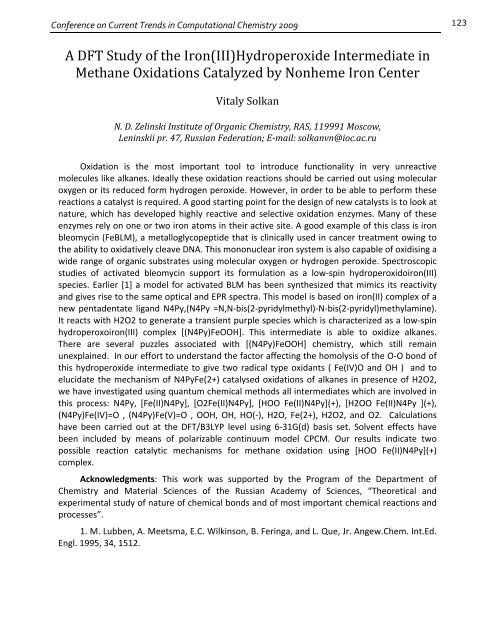Proceedings - Interdisciplinary Center for Nanotoxicity
Proceedings - Interdisciplinary Center for Nanotoxicity
Proceedings - Interdisciplinary Center for Nanotoxicity
Create successful ePaper yourself
Turn your PDF publications into a flip-book with our unique Google optimized e-Paper software.
Conference on Current Trends in Computational Chemistry 2009<br />
A DFT Study of the Iron(III)Hydroperoxide Intermediate in<br />
Methane Oxidations Catalyzed by Nonheme Iron <strong>Center</strong><br />
Vitaly Solkan<br />
N. D. Zelinski Institute of Organic Chemistry, RAS, 119991 Moscow,<br />
Leninskii pr. 47, Russian Federation; Email: solkanvn@ioc.ac.ru<br />
Oxidation is the most important tool to introduce functionality in very unreactive<br />
molecules like alkanes. Ideally these oxidation reactions should be carried out using molecular<br />
oxygen or its reduced <strong>for</strong>m hydrogen peroxide. However, in order to be able to per<strong>for</strong>m these<br />
reactions a catalyst is required. A good starting point <strong>for</strong> the design of new catalysts is to look at<br />
nature, which has developed highly reactive and selective oxidation enzymes. Many of these<br />
enzymes rely on one or two iron atoms in their active site. A good example of this class is iron<br />
bleomycin (FeBLM), a metalloglycopeptide that is clinically used in cancer treatment owing to<br />
the ability to oxidatively cleave DNA. This mononuclear iron system is also capable of oxidising a<br />
wide range of organic substrates using molecular oxygen or hydrogen peroxide. Spectroscopic<br />
studies of activated bleomycin support its <strong>for</strong>mulation as a low‐spin hydroperoxidoiron(III)<br />
species. Earlier [1] a model <strong>for</strong> activated BLM has been synthesized that mimics its reactivity<br />
and gives rise to the same optical and EPR spectra. This model is based on iron(II) complex of a<br />
new pentadentate ligand N4Py,(N4Py =N,N‐bis(2‐pyridylmethyl)‐N‐bis(2‐pyridyl)methylamine).<br />
It reacts with H2O2 to generate a transient purple species which is characterized as a low‐spin<br />
hydroperoxoiron(III) complex [(N4Py)FeOOH]. This intermediate is able to oxidize alkanes.<br />
There are several puzzles associated with [(N4Py)FeOOH] chemistry, which still remain<br />
unexplained. In our ef<strong>for</strong>t to understand the factor affecting the homolysis of the O‐O bond of<br />
this hydroperoxide intermediate to give two radical type oxidants ( Fe(IV)O and OH ) and to<br />
elucidate the mechanism of N4PyFe(2+) catalysed oxidations of alkanes in presence of H2O2,<br />
we have investigated using quantum chemical methods all intermediates which are involved in<br />
this process: N4Py, [Fe(II)N4Py], [O2Fe(II)N4Py], [HOO Fe(II)N4Py](+), [H2OO Fe(II)N4Py ](+),<br />
(N4Py)Fe(IV)=O , (N4Py)Fe(V)=O , OOH, OH, HO(‐), H2O, Fe(2+), H2O2, and O2. Calculations<br />
have been carried out at the DFT/B3LYP level using 6‐31G(d) basis set. Solvent effects have<br />
been included by means of polarizable continuum model CPCM. Our results indicate two<br />
possible reaction catalytic mechanisms <strong>for</strong> methane oxidation using [HOO Fe(II)N4Py](+)<br />
complex.<br />
Acknowledgments: This work was supported by the Program of the Department of<br />
Chemistry and Material Sciences of the Russian Academy of Sciences, “Theoretical and<br />
experimental study of nature of chemical bonds and of most important chemical reactions and<br />
processes”.<br />
1. M. Lubben, A. Meetsma, E.C. Wilkinson, B. Feringa, and L. Que, Jr. Angew.Chem. Int.Ed.<br />
Engl. 1995, 34, 1512.<br />
123



